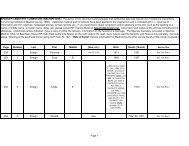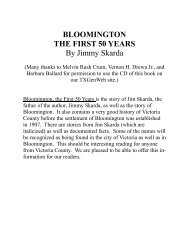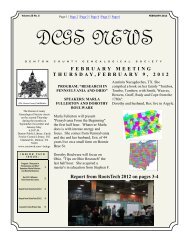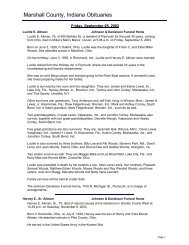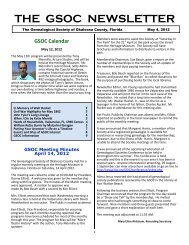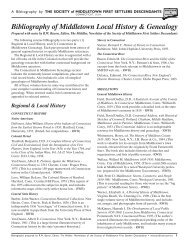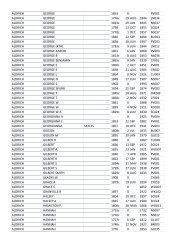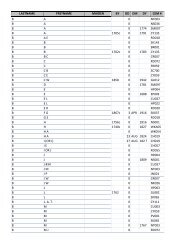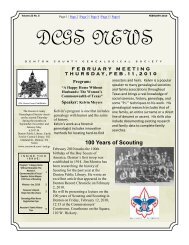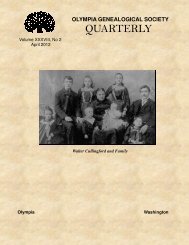Indian population in the United States and Alaska. 1910 - RootsWeb
Indian population in the United States and Alaska. 1910 - RootsWeb
Indian population in the United States and Alaska. 1910 - RootsWeb
Create successful ePaper yourself
Turn your PDF publications into a flip-book with our unique Google optimized e-Paper software.
96<br />
<strong>in</strong> Washiagton, but no <strong>in</strong>formation was given as to<br />
particular tribes.<br />
SHASTAN STOCK.<br />
Stock as a whole.—The area occupied by "this stock<br />
comprises portions of Siskiyou, Shasta, Lassen, <strong>and</strong><br />
Modoc Coimties <strong>in</strong> nor<strong>the</strong>rn California.<br />
The <strong>Indian</strong>s of <strong>the</strong> Shastan stock, as enumerated <strong>in</strong><br />
<strong>1910</strong>, numbered 1,578. The tribes of this stock, for<br />
which members were reported, are as follows<br />
Hat Creek. Pit River. Shasta.<br />
Hat Greek.—One of <strong>the</strong> three ma<strong>in</strong> subdivisions of<br />
this stock <strong>and</strong> as a tribe closely affiliated with <strong>the</strong> Pit<br />
Eiver. Siace earhest traditional times <strong>the</strong>y have<br />
occupied a small area ia nor<strong>the</strong>astern California,<br />
compris<strong>in</strong>g Dixie Valley <strong>and</strong> <strong>the</strong> region along Hat<br />
Creek <strong>in</strong> eastern Shasta <strong>and</strong> western Lassen Coun-<br />
ties. The Hat Creek <strong>Indian</strong>s have never had any reser-<br />
vation <strong>and</strong> are liv<strong>in</strong>g scattered over <strong>the</strong>ir orig<strong>in</strong>al<br />
territory. The number enumerated ia <strong>1910</strong> was 240,<br />
all ia California.<br />
Pit River.—One of <strong>the</strong> three ma<strong>in</strong> subdivisions of<br />
this stock, <strong>and</strong> as a tribe most closely affiliated with<br />
<strong>the</strong> Hat Creek. S<strong>in</strong>ce earliest traditional times <strong>the</strong>y<br />
have occupied a smaJl area <strong>in</strong> nor<strong>the</strong>astern California,<br />
comprisiag <strong>in</strong> general <strong>the</strong> greater part of <strong>the</strong> dra<strong>in</strong>age<br />
bas<strong>in</strong> of Pit River except<strong>in</strong>g, however, Dixie Valley<br />
<strong>and</strong> <strong>the</strong> valley of Hat Creek. The majority of <strong>the</strong><br />
tribe now rema<strong>in</strong><strong>in</strong>g are scattered over <strong>the</strong>ir orig<strong>in</strong>al<br />
territory <strong>and</strong> are not located on any reservation. A<br />
small number were taken to Round Valley Reservation<br />
soon after its establishment, some of whom stiU rema<strong>in</strong><br />
<strong>the</strong>re, <strong>and</strong> a few are on <strong>the</strong> Klamath Reservation,<br />
Oreg. The number enumerated <strong>in</strong> <strong>1910</strong> was<br />
985, of which 888 were <strong>in</strong> California.<br />
Shasta.—One of <strong>the</strong> three ma<strong>in</strong> subdivisions of this<br />
stock <strong>and</strong> that from which <strong>the</strong> stock "has taken its<br />
name. S<strong>in</strong>ce earhest traditional times <strong>the</strong>y have occupied<br />
an area <strong>in</strong> nor<strong>the</strong>rn California <strong>and</strong> sou<strong>the</strong>rn<br />
Oregon, compris<strong>in</strong>g <strong>the</strong> central portion of Siskiyou<br />
Coimty, Cal., <strong>and</strong> part of <strong>the</strong> sou<strong>the</strong>rn portion of Jackson<br />
Coimty, Oreg. The majority of <strong>the</strong> tribe now rema<strong>in</strong><strong>in</strong>g<br />
are scattered over <strong>the</strong>ir orig<strong>in</strong>al territory <strong>and</strong><br />
are not on reservations. A few, however, rema<strong>in</strong> at<br />
Gr<strong>and</strong>e Ronde <strong>and</strong> Siletz Reservations, <strong>in</strong> Oregon,<br />
where a considerable portion of <strong>the</strong> tribe was kept for<br />
several years as <strong>the</strong> result of <strong>the</strong> Rogue River War.<br />
A portion of <strong>the</strong> Shasta is sometimes known as Scott<br />
Valley <strong>Indian</strong>s <strong>and</strong> <strong>the</strong> rema<strong>in</strong>der has at times been<br />
called Klamaths. The Shasta, as enumerated <strong>in</strong> <strong>1910</strong>,<br />
niunbered 353, distributed as follows: California, 255;<br />
Oregon, 96; Wash<strong>in</strong>gton, 2.<br />
SHOSHONEAN STOCK.<br />
Stock as a whole.—One of <strong>the</strong> largest stocks <strong>in</strong> <strong>the</strong><br />
<strong>United</strong> <strong>States</strong>. The ma<strong>in</strong> area occupied by this stock<br />
Ues <strong>in</strong> <strong>the</strong> <strong>in</strong>terior plateau <strong>and</strong> <strong>in</strong>cludes practically <strong>the</strong><br />
whole of Nevada <strong>and</strong> Utah <strong>and</strong> part of eastern Ore-<br />
:<br />
INDIANS IN THE UNITED STATES.<br />
:<br />
gon, sou<strong>the</strong>rn Idaho, southwestern Wyom<strong>in</strong>g, western<br />
Colorado, <strong>and</strong> sou<strong>the</strong>rn California. In addition, <strong>the</strong><br />
Comanche occupied at times a portion of <strong>the</strong> pla<strong>in</strong>s <strong>in</strong><br />
Texas <strong>and</strong> eastern New Mexico. Small areas <strong>in</strong> north-<br />
ern Arizona were alao occupied by tribes belong<strong>in</strong>g to<br />
this stock.<br />
The <strong>Indian</strong>s of <strong>the</strong> Shoshonean stock, as enumer-<br />
ated <strong>in</strong> <strong>1910</strong>, niunbered 16,842. To this figure should<br />
be added probably about 1,000 for <strong>Indian</strong>s of this<br />
stock reported without dist<strong>in</strong>ction of tribe among <strong>the</strong><br />
general <strong>population</strong> <strong>in</strong> Nevada, Utah, Colorado, Idaho,<br />
<strong>and</strong> California, mak<strong>in</strong>g a probable total of about 18,000<br />
<strong>in</strong> all. The tribes of this stock, for which members<br />
were reported, are as follows:<br />
Bannock. Kawia. San Ltuseno.<br />
Chemeliuevi. Kern River. Serrano.<br />
Comanclie. Mono. Shoshoni.<br />
Gabrieleno. Pahvant. Tehachapi.<br />
Hopi. Paiute. Ute.<br />
Juaneno. Panam<strong>in</strong>t.<br />
Kawaiisu. Paviotso.<br />
Bannock.—The tribal name is of somewhat uncer-<br />
ta<strong>in</strong> extension <strong>and</strong> has been applied <strong>in</strong> <strong>the</strong> past with<br />
considerable laxity. The early habitat of this tribe<br />
seems to have been <strong>in</strong> sou<strong>the</strong>astern Idaho <strong>and</strong> <strong>the</strong> ad-<br />
jacent portions of northwestern Wyom<strong>in</strong>g <strong>and</strong> southwestern<br />
Montana, with a probable extension westward<br />
<strong>in</strong>to southwestern Idaho nearly to <strong>the</strong> Oregon l<strong>in</strong>e.<br />
For at least 50 years <strong>the</strong>y have been closely associated<br />
with <strong>the</strong> Shoshoni. S<strong>in</strong>ce 1869 <strong>the</strong>y have been located<br />
pr<strong>in</strong>cipally on <strong>the</strong> Fort HaU Reservation <strong>in</strong> Idaho,<br />
with a smaller b<strong>and</strong> at Lemhi <strong>in</strong> <strong>the</strong> same state.<br />
The number enumerated <strong>in</strong> <strong>1910</strong> was 413, of which<br />
363 were <strong>in</strong> Idaho. Early estimates of <strong>the</strong> <strong>population</strong><br />
of <strong>the</strong> Bannock would seem almost certa<strong>in</strong> to have been<br />
exaggerated <strong>and</strong> to have <strong>in</strong>cluded under this name portions<br />
of o<strong>the</strong>r tribes. In 1829, for example, <strong>the</strong> Bannock<br />
were said to number approximately 8,000, a fig-<br />
urfe which had decreased to less than 1,000 <strong>in</strong> 1870.<br />
Between 1875 <strong>and</strong> 1899 <strong>the</strong> Bannock were retutned<br />
separately <strong>in</strong> <strong>the</strong> reports of <strong>the</strong> Commissioner of In-<br />
dian Affairs, <strong>the</strong> figures for this tribe <strong>in</strong> Idaho be<strong>in</strong>g as<br />
foUows<br />
YEAB.



